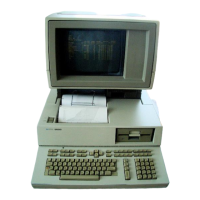2-32
Theory
of
Operation
The keyboard service request latch
is
set when the keyboard microprocessor outputs a keycode to
the output register. Then,
on
the next polling cycle, bit 6
on
the lOP bus
is
set, signifying to the
processor that a peripheral
on
SC6
is
requesting service.
Two 8-bit bus test latches have their inputs
and
outputs tied to the bus.
At
power-up, operating
system code tests data path integrity by writing data into
and
then reading the data from these
latches via
RI5.
Keyboard and Input Device Scanning
The keyswitch board scans 15 columns of keys with 8 keys
per
column. It interconnects with the
keyboard electronics board via a
20-pin ribbon cable
and
the electronics
board
bus connector
(KBOC).
The keyboard microprocessor, which resides on the keyboard electronics board, has 1 K bytes of
ROM
and
64
bytes of
RAM.
The microprocessor constantly scans, or interrogates, the keyswitch
board. It sends the 4-bit column address to the keyswitch board. That board responds by sending
the status of
all
8 keys of the specified column to the microprocessor, which processes the data. It
then sends the next column address,
and
the process continues.
When a new key
is
pressed, the microprocessor translates the address of the key into a 7 -bit
keycode which
it
then shifts into a holding register along with two status bits: Shift
and
Control. A
service request signal
is
then sent to the lOP bus. The lOP responds by reading RIO. Lockout logic
prevents overwriting of the keycode
in
the holding register for a maximum of
2.25
ms, enabling
it
to
be
read by the lOP.
The keyboard microprocessor controls the two LEOs on the keyboard
and
the initial delay
and
repeat rate of keys which are held down. When a key
is
pressed
on
the keyboard which requires
an
LEO change, that keycode
is
sent to the lOP which
in
turn responds by updating
all
LEOs
and
the
auto-repeat rate by writing to
RIO.
The auto-repeat rate determines the initial delay
and
repeat interval of keys that are continuously
held down. The default
is
500-millisecond delay
and
20-millisecond repeat interval. Another
30
combinations can
be
selected.
The desired keyboard language
is
determined by the insertion/deletion of four resistors
on
the
keyboard electronics board. This
I-of
-16 language code
is
translated by the operating system to
select the predetermined language. A replacement keyboard electronics
board
is
configured for
ASCII
and
has
all
resistors in place. Refer to Chapter 4 for the language/resistor combinations
and
Chapter 5 for language/keycap configurations.
Buffers
on
the processor
board
provide isolation for signals from the optional input device.
The
input device plugs into connector TB located at the right front of the computer,
under
the keyboard.

